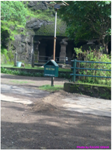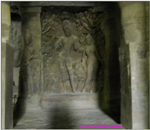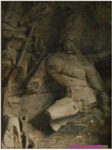Elephanta caves: historical significance

The Elephanta Caves are symbol of rich Indian historical architecture. These caves are sited in Western India on Elephanta Island which characterizes two small hills separated by a thin valley. The small island is scattered with several primordial archaeological remains that are the single testimonies to its rich civilizing past. These archaeological remnants represent evidence of occupation from as early as the 2nd century BC. The rock-cut Elephanta Caves were built about the mid-5th to 6th centuries AD.
Among five caves in Elephanta Island, the great Cave 1 has huge significance which measures 39 metres from the front entrance to the back. In plan, this cave in the western hill directly resembles Dumar Lena cave at Ellora, in India. The main body of the cave, excluding the porticos on the three open sides and the back aisle, is 27 metres square and is supported by rows of six columns each.
The 7-metre-high masterwork "Sadashiva" governs the access to Cave 1. The statue symbolizes three aspects of Shiva: the Creator, the Preserver, and the Destroyer, identified, correspondingly, with Aghora or Bhairava (left half), Taptapurusha or Mahadeva (central full face), and Vamadeva or Uma (right half). Depictions of Nataraja, Yogishvara, Andhakasuravadha, Ardhanarishwara, Kalyanasundaramurti, Gangadharamurti, and Ravanaanugrahamurti are also remarkable for their forms, dimensions, themes, images, content, and position and finishing.
Cave also has numerous carvings of general significance to world art of olden times that include a carving of Shiva and Parvati on Mount Kailash with numerous other characters and comprehensive scenery features. There are fifteen huge panels containing art values in total. Entrance of eastern part of cave is safeguarded by seated tigers that resemble later seated lions popular up to 19th century in European manor house designs. Eastern part of cave contains a gigantic statue of four-armed gate keeper with two demons attendants.
The design of the caves, including the pillar components, the situation and division of the caves into different parts, and the provision of a sanctum or Garbhagriha of sarvatobhadra plan, are important developments in rock-cut structural design. The Elephanta Caves become known from a long artistic custom, but show refreshing modernization. The blend of artistic beauty and sculptural art, stuffed with respondent Rasas, reached an apogee at the Elephanta Caves. Hindu spiritualistic beliefs and symbology are delicately utilized in the general planning of the caves.

All the archaeological elements in the Elephanta Caves are conserved in their usual settings. The realism of the possessions has been retained since its caption on the World Heritage List, in spite of certain repairs on the facade and pillars that have been done to make certain the structural steadiness of the monument. Besides the caves, Elephanta Island also possesses archaeological leftovers from as early as the 2nd century BC and from the Portuguese period, as witnessed, correspondingly, by stupas buried towards the eastern side of the hillock and a canon located at its top. Historical records indicated architectonic features of Elephanta cave chambers and their details.
These depict that cave chambers were made in the period between 5th to 8th centuries AD. Earlier there existed an inscription in the caves or near them informing about the builder of caves but it has been lost later, during the Portuguese periods. One architect of caves is Konkan Mauryas break-away group of Mauryan dynasty.
Elephanta at that time was called Puri or Purika and was a capital city. It is assumed that caves were remodelled in the middle of 6th century by Mauryas. It is also probable that caves were built by early Kalachuri kings they were feudals to Konkan Mauryas.
Both Kalachuris and Konkan Mauryas were followers of a Pahsupata Shaivism sect and also the main cave temple in Elephanta is dedicated to this faction. Elephanta caves greatly attract tourists from all over the world for its ancient archaeology. Elephanta Island is quiet and charming, with light-green foliage and monkeys run around. It is advised to tourists that they should not bring food to avoid attraction of the monkeys. There is a huge hall at the entrance of these caves. Other sculptures near the doorways and on side panels celebrate Shiva's accomplishments.

The attractiveness of this stonework lies in the elegance, balance, and sense of peace conveyed in spite of the subject's multiple actions. Tourist can fully enjoy the natural beauty of this spot. One statue shows Shiva bringing the Ganges River down to Earth, letting it drop through his matted hair. He is also depicted as Yogisvara, lord of Yogis, seated on a lotus, and as Shiva Nataraja, the many-armed cosmic dancer. Information for tourists: All visitors can go via sea route to Elephanta caves as caves are only accessed by sea ways. There are regular ferries that leave from Mumbai's Gateway of India harbour throughout the year, except during the monsoon season. As per latest information, these caves are closed on Monday therefore tourists can plan a trip on other days.
When entering to caves, there is a nominal entrance fee. Best time to visit the island is November to March. The site of the caves is very stunning and scenic as it is surrounded by Arabian Sea. The picturesque of the place is very godly and peaceful with lots of abundant greenery around accompanying with the gentle wind coming from the sea.In final words, Elephanta is a small Island in the port of Bombay. Elphanta island is for tourists who are fond of researching archaeological sites.
These ancient caves were formed to dedicate it to Lord Shiva. The caves are preserved in the form of monumental temples, sarvatobhadra garbhgriha (sanctum), mandapa (courtyard), rock-cut architecture, and sculptures. Since inscription, a number of developments have been made to attract the tourists and to preserve the location.
These include the building of pathways, conservation of fallen and broken pillars, conservation of fallen and collapsed facades, construction of steps leading to the caves from island's landing stage, renovate to the Custodian's Quarters, and setting up of a Site Information Centre.
Some of the Major Architecture in Ancient & Medieval Times in India
Contribute More Facts